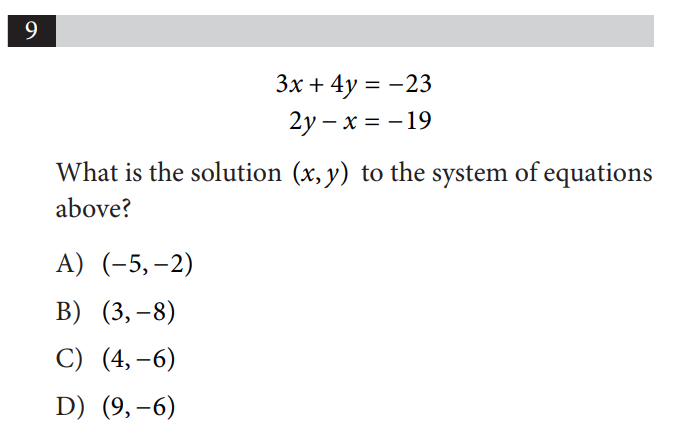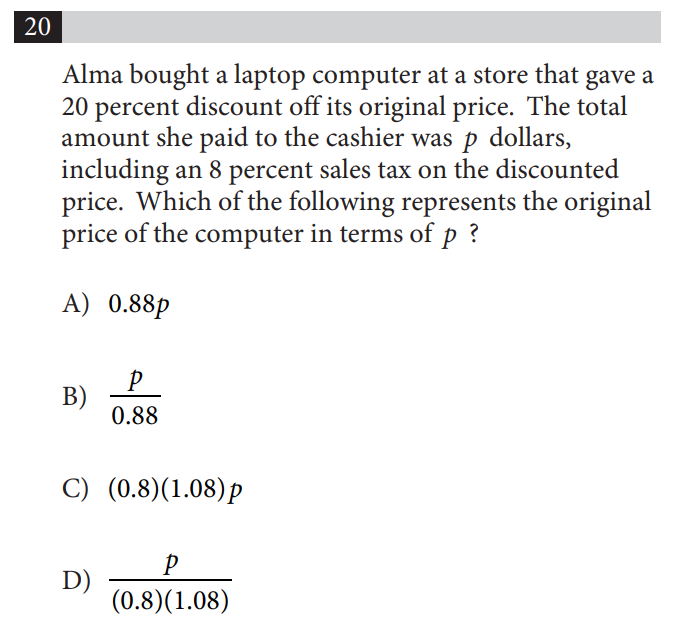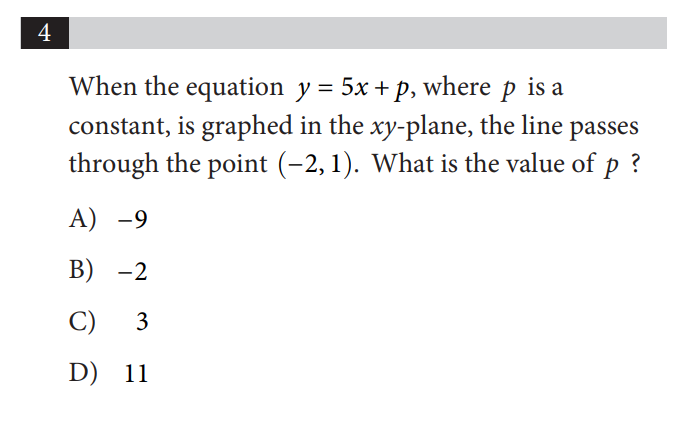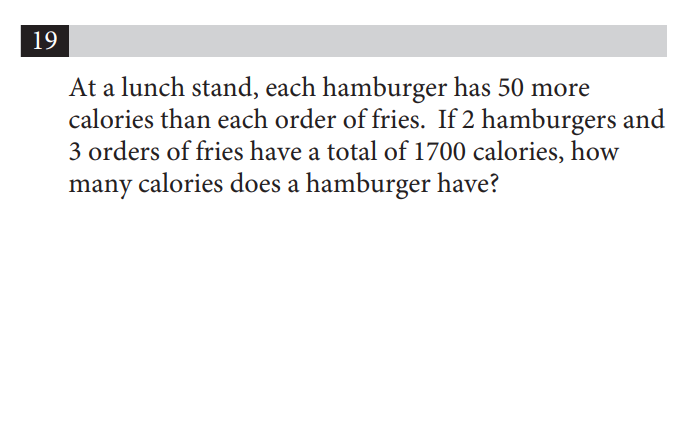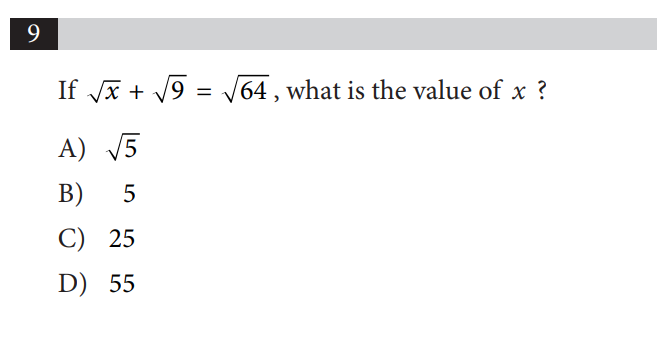In the SAT, you will have 4-5 sections on the test (depending on whether you choose to take the essay section or not)! The sections are:
Reading
Grammar/English
Math (No-Calculator)
Math (Calculator Allowed)
Writing/Essay (⚠️ OPTIONAL ⚠️)
As you can see, math is a pretty important topic on the SAT, since it makes up about 50% of the sections on your test. In this study guide, you will learn about logistics, strategies, content, and some overall tips to ace your Math No-Calculator AND Calculator sections.
On both math sections, the first page will be a formula sheet with all of this information, mainly to help you in the Additional Topics Domain, but more on that later 👀 Try to memorize all these formulas because it can save you a lot of time on test day (because of flipping back and forth between pages 📖), but be aware that you will have the reference sheet for the test:
Image Courtesy of the College Board’s SAT Overview PDF
What is a Global Strategy? That phrase means that the strategy can be applied on any standardized test 👍 These global strategies can also help you get through the other 2 sections of the SAT faster, ⌛ so let's take a look at some of these:
This one is simple and you've probably used it on many multiple-choice tests throughout your academic career without even realizing it! If your options are A, B, C, or D, and you know for sure it can’t be A or C, then you can eliminate those two.
Guess either B or D, and you have a 50% chance of getting that question correct! That is DOUBLE ****your chances of getting the question correct by randomly guessing, but more on that later 👍
On the exam, you might get a question that you are simply stumped on ☹️ It happens to all of us. But the clock ⏳ is still ticking. If you really just don’t know, make your best guess, circle the question so you can come back if you have time, and then move on. It’s better to miss that one hard question than to not have time for the 10 easy ones that you could get right at the end of the exam.
If you do have to randomly guess on a question on your exam, IT WILL BE OKAY!! There is 1 strategy to help your score when you do have to randomly guess, and it is to pick 1 Letter of the Day (LOTD). Pick A, B, C, or D before you start your test, and mark that one answer for ALL of the questions that you have to randomly guess on. You will increase your probability of getting each individual question correct ❗
Sometimes you understand the concept, just not the question. Take the question out of fancy SAT language and convert it into phrasing you understand. Also, try to brainstorm everything that you know and write it down in concise statements next to the question. This can help you to understand what the question is asking you to do and can be very helpful for word problems!
To use The End, all you have to do is finish reading the question before you start working it.
This strategy makes you slow down to make sure that you are actually solving the question that you are supposed to be answering. It might seem like common sense, but using this one tip can actually help you increase your score and stop making simple mistakes 😢
WOW 🤯 This might not seem revolutionary, but everyone has made this mistake before by rushing and starting to solve the problem before you even get to the "?". Look at the example below for ideas on how this strategy might help.
Courtesy of SAT Practice Test 9 - Section 3 - NO CALCULATOR
Why did you get it wrong? You got the correct answer for $x$! You didn't use 🔚 The End! So let's go back to the question, and try using the strategy.
The question asked you for the answer to $2x+1$, not just $x$ 😭 If you read the question before you started working the problem, you would have seen that the correct answer would be 2 and not $x=0.5$.
Make sure to use 🔚 The End so that you don't miss any more easy level questions because of reading errors!
This strategy has 2 applications for you, as it is one of the most versatile strategies for the math section. Make sure to keep this one handy 🎉 Let's differentiate between the 2 applications by calling them The OG Plug and The Plug 5.0 👍
To use The OG Plug, all you have to do is pick some easy numbers to work with and plug them in for your variables in the question, then check that against the answers!
This strategy can help you solve almost any problem on this section involving variables, and especially problems with more than 1 use of a variable! Let's look at a practice problem together to look at this strategy in action 🦸:
Image Courtesy of SAT Practice Test 1 - Section 3 - NO CALCULATOR
If you try to solve this problem with your algebra 2 ➗ knowledge, it can get really complicated with fractions and double variables 😳
However, 🔌The OG Plug can make this problem super simple for most people! Since the problem says that $x > 3$, then we just need to pick a value for X greater than 3 to plug in.
So, let's pick 4 for x!
When we use 🔌The OG Plug with $x=4$, then we get: 42/13
After substituting for $x=4$ in all of the answer choice, we can learn that the correct answer is
Now all we have to do is plug in our number for x in all of the answer choices and see what matches the problem 👍
Answer B solves for 42/13 which is equal to our solution to the original problem ☺️
If you used algebra and added the fractions with the FOIL method and too many other steps, then you should reach the same conclusion!
To use The Plug 5.0, all you have to do is plug the numbers from the answers into the question and see which yields the right result!
Image Courtesy of SAT Practice Test 1 - Section 3 - NO CALCULATOR
If you try solving this system with elimination or substitution, you will end up with some really big numbers, or it will take a long time with lots of algebra! But using 🔌The Plug 5.0, the answers can tell us which one is correct 🎊 !!
We just need to plug in the ordered pairs for X and Y for each answer choice and check which pair solves both equations! Let's start with letter B in the second equation 👍 now we get that:
That equation is true! Since we picked an awesome ✨ answer choice to start with, let's just double-check the first equation before marking the correct answer
When we plug in (3,-8) to the first equation, we get that:
which is also true 🎉!! That means that Answer Choice B is correct 😎 Let's mark that and move on without using any algebra.
This strategy helps you break up complex questions on the SAT Math section. Break it Down 💔 can help you answer questions that have too many variables or have tons of fractions by solving parts of an equation to put them back together 🎊
To use Break it Down, pick steps to break up different parts of the equation, solve them independently, then put all the pieces back together!
This strategy can help you solve almost any problem in this section involving:
Multiple variables
Fractions
Percentages
Ratios
Let's look at a practice problem together to look at this strategy in action 🦸:
Image Courtesy of SAT Practice Test 1 - Section 4 - CALCULATOR
When you read this question, it might be nice to use the Rephrase Global Strategy 🌍 that we discussed earlier, but you can solve it just as easily with ⬇️ Break it Down. So, the first thing that we need to do is define the variables 🔤 and the percentages.
We know 🧠 that:
Those 3 pieces of knowledge (plus defining variable o = original price) are how we are going to ⬇️ Break it Down 😎.
Our first step is that 20% off means that we will be subtracting from the original price.
We now know that p=0.8* o!
We also know that there is a sales tax of 8% so that would be adding to price. So, we know that p = 1.08 * 0.8 * o!
Now all we need to do is take the equation and put it in terms of p.
So if we divide both sides by (1.08 * 0.8),
Then we get that D*p/(0.8*1.08) is the correct answer
🙋 Time to mark that and move on 😎
This strategy is a huge time-saver when you are taking your SAT Math. Close Enough can help you eliminate answers and easily see the correct one 👍
To use Close Enough, try to use common sense to see which answers are way too big or small, then find a realistic answer. Look at the answers before solving!
This strategy can help you solve almost any problem in this section involving difficult 😤 concepts, and is especially useful for multi-step problems. Let's look at a practice problem together:
To use Close Enough, try to use common sense to see which answers are way too big or small, then find a realistic answer. Look at the answers before solving!
This strategy can help you solve almost any problem in this section involving difficult 😤 concepts, and is especially useful for multi-step problems. Let's look at a practice problem together:
Image Courtesy of PSAT Practice Test 2 - Section 4 - CALCULATOR
When you start this problem the BIGGEST TIP 💡(besides 👉👈 Close Enough) is to 🎨 Sketch it Out! Whenever you have a problem that involves an equation with an ordered pair (or a graph without one given), you should 🎨 Sketch it Out! on a hand-drawn graph!
Sketch it Out : Self-Created; This graph shows you that you drawing don't have to be perfect to get the idea!
To use 👉👈 Close Enough, we just need to analyze 👀 our sketch and find the direction of the slope. The line has a positive ➕ slope, meaning that the line will increase in Y and X, or decrease in Y and X. With that knowledge, we know that our Y-intercept will be higher than the current Y value of our point.
We can immediately Eliminate 🧐 A and B, since those points too low. Since the slope is 5/1, that means that the slope has a larger "rise" (in Y) than "run" (in X)! That means that our Y-intercept will be D. 11, since it is the highest value possible 👍 Now we get to mark that and move on!
This is less of a strategy and more of an overall tip for the SAT Math Calculator (Section 4) 💡
While you are allowed to use your calculator for all of section 4, one of the biggest issues is knowing when to use your calculator and when not to! While when to use a calculator is slightly a personal decision, we have a general rule of thumb 👍 for recognizing when it's needed:
To choose when to Calculate, you need to read the problem and decide whether there is a calculator function to solve the whole question. Also, you can Calculate to do simple arithmetic always to avoid simple mistakes!
There is no practice problem to review this strategy 😥 so just use this strategy when you need it. When you see $1463 \times 17$ on your SAT, you probably need a calculator, but some people might not 🤔 so learn your own strengths 💪 and weaknesses before your SAT!
Since the SAT covers 3️⃣ whole years of High School Math (Algebra 1, 2, and Geometry/Trig), we would need 10 of these study guides to review all of the required content 😂 However, we can link to some AWESOME 🤩 videos and study guides to help you review all of the math that you need to review to ace the SAT:
**Khan Academy—**Reviews all of the content through videos and practice questions and breaks material down into the 4 categories that we just discussed above. Khan Academy also partners with the College Board so that you can sync your current PSAT and SAT scores to help pinpoint your strong 💪 and weak 🐶 areas. Here is a preview of one of their lessons:
Image Courtesy of Khan Academy Heart of Algebra
Ivy Global Math Review—This is a 40 page PDF that describes all of the content on the SAT Math sections. This PDF is awesome because it's succinct and sectioned into different content areas than the SAT Domains, so you get another perspective 🤔 on the content. The PDF does not cover everything that Khan Academy does, but this does make it easy to work practice ➗ problems and annotate the content sections. Here is a preview of the PDF :
Image Courtesy of Ivy Global Math Review
The Organic Chemistry Tutor's Math SAT YouTube Review—Helps cram all of the SAT Math content into your brain in 2.5 hours. This review is best for students that are already strong in the math sections or have very little time ⏳ to review for the test. This review has math problems throughout for watchers to practice in all 8 of the mini-lessons in the video 🎦 This review is the shortest on the list and can just refresh you on the most difficult concepts on the test.
Image Courtesy of YouTube
You will need to have learned all of Algebra 2 to master the content in this section!
The College Board has published a list of topics in 4️⃣ categories that you need to focus to succeed on the SAT! We can break up all of the categories with emojis 😂 so make sure to remember them when we discuss strategies:
💙 Heart of Algebra: 19 questions on the SAT
Linear Equations
Systems of Equations
Functions + Notation
📉 Problem Solving and Data Analysis: 17 questions on the SAT
Ratios, Percentages, + Proportions
Reasoning with Data
Using Statistics + Probability
Modeling Data (Using Graphs, Charts, and Tables)
🔑 Passport to Advanced Math: 16 questions on the SAT
Multiplying + Factoring Polynomials
Integer + Radical Exponents
Quadratic, Radical, Rational, Polynomial, + Absolute Value Equations
All of the topics in Passport to Advanced Math are building on the skills in Heart of Algebra.
You won't need to know all of the SAT Domains and be able to recognize 🧐 them on test day, but when you get your score report, you get sub-scores based on these categories. The scale is from 1-15 so you will be looking for a 1️⃣5️⃣ in all of your sub-scores 🎊
We have curated 11 practice problems for you to try from each of the SAT Domain Categories so that you can find your Strengths 💪 + Weaknesses 🐶 before test day 🎉 Try to time yourself for about 12-14 minutes because that correlates to the amount of time you will have on test day.
{Note: the Problem Solving + Data Analysis Questions are from Section 4 since they are only tested on that section}
GOOD LUCK 🤞 but you won't need it 🙃
Courtesy of SAT Practice Test 3 - Section 3 - NO CALCULATOR
Courtesy of SAT Practice Test 3 - Section 3 - NO CALCULATOR
Courtesy of SAT Practice Test 3 - Section 3 - NO CALCULATOR
Courtesy of SAT Practice Test 3 - Section 3 - NO CALCULATOR
Courtesy of SAT Practice Test 5 - Section 4 - CALCULATOR
Courtesy of SAT Practice Test 5 - Section 4 - CALCULATOR
Courtesy of SAT Practice Test 5 - Section 4 - CALCULATOR
Courtesy of SAT Practice Test 6 - Section 3 - NO CALCULATOR
Courtesy of SAT Practice Test 6 - Section 3 - NO CALCULATOR
Courtesy of SAT Practice Test 6 - Section 3 - NO CALCULATOR
Courtesy of SAT Practice Test 6 - Section 3 - NO CALCULATOR
Make sure to check your work 👨💼 and see where you struggled 😖 so you can improve next time! There are solutions for every questions and the possible strategies that could be used 🔥 The explanations for all of the questions are
on this website so check those out if you don't understand 😕 where the answer came from!
There were more medium and hard questions than easy questions on the practice problems, so don't feel bad about missing a few 🙌
C; The best strategy to use here would be to pick small numbers to use for 🔌 The OG Plug for X + Y and see which expression matches your original solution.
D; For this question, make sure to 🎨 Sketch it Out on a graph and see how the slope goes through points besides the origin a.k.a (0, 0).
D; For this question, using ⬇️ Break it Down is good to rewrite/check the equation to see which of each I, II, and III are true.
370; For this question, you should try to ✍️ Rephrase the question from English —> Math and solve your system.
A; This problem doesn't have a major strategy since it is just plugging in numbers and dividing from the data table 😭
C; This problem, again, doesn't have a major strategy since it is just multiplying numbers from the problem 😭
C; This problem involves using ✍️ Rephrase to translate the question from English —> Math and solve for your mean.
C; This problem doesn't have a major strategy since it is just solving the radicals & subtracting 😭
D; The best strategy to use here would be to pick small numbers to use for 🔌 The OG Plug for X and see which expression matches your original solution.
D; There are 2 main ways to solve this problem:
Using an algebraic formula and recognizing that (a+b)^2=(a^2+2ab+b^2)
OR using 🔌 The OG Plug for A + B and see which expression matches your original solution.
30; This problem can use 🎨 Sketch it Out and drawing 2 triangles to try to see which sides are parallel and equal to find the ratio since these triangles are similar.
Here is a final review of everything in this guide in a simple bullet-point format: 😂
SAT Math is 2 of your 4 sections on the Test (+ the Essay, but that's optional)
The No-Calc (Section 3) is shorter than the Calc (Section 4) portion
You will get the same formula sheet ✖️ on both sections, but we recommend memorizing it
Both sections have a combination of MCQs and GIs
There are 4 major strategies for ALL Sections of the SAT on test day:
Elimination: Mark out answers that you know are incorrect then pick from the remaining
Mark It: Don't spend too long on one question; Mark it and move on with your LOTD
Letter of the Day: Pick one letter before the test and mark it for all of the guess questions
Rephrase: Sometimes you get the concept but not the question, so put it in new words
There are 5 major strategies to use on the math section on test day:
The End: Make sure to answer what the question is asking
The Plug: Substitute real numbers for the variables and check against the answer choices
Break It Down: Piece together the problem from solvable pieces instead of all at once
Close Enough: Eliminate answers that are wayy too big or small; Find the medium
Calculate: Only use your calculator when you need it for complex equations with big numbers
While strategy is awesome to help improve your score, practice is what makes progress permanent!
Content knowledge is also important for the math sections so make sure to learn all of Algebra 2, if possible, before taking your SAT!
The SAT is broken up into 4 "Domains" of content so know what fits into the bigger categories to see what to do to improve your score the most
Again: PRACTICE, PRACTICE, PRACTICE!



